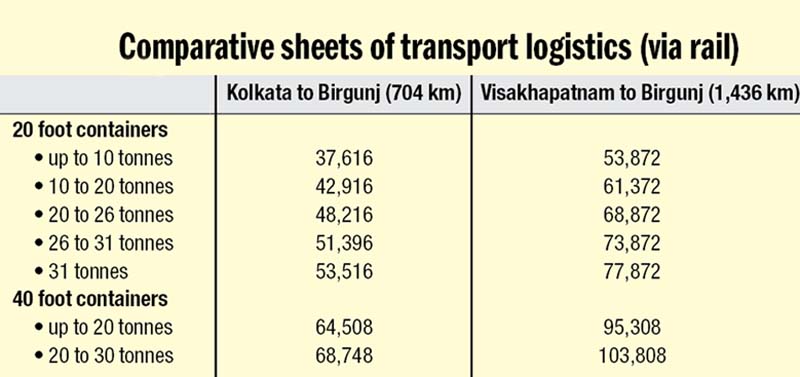Trade through Vizag Port could be more feasible
Kathmandu, August 5
As the country is preparing to utilise Visakhapatnam (Vizag) Port as another gate way for third country trade, traders stand to benefit from efficient services of the port and low ocean freight cost from the origin sea port as compared to Kolkata Port. Cost of transporting cargoes to and from Vizag Port, however, is significantly higher when compared with Kolkata Port.
Comparing the rate sheets of the two ports, it costs INR 72.29 (including port charges and rail fare) per kilometre to transport 30 tonnes of cargo from Vizag Port to Nepal, while it costs INR 97.65 per km from Kolkata Port. Hence, third country trade via Vizag Port would be more viable compared to Kolkata Port. “If Kolkata Port maintains high efficiency, country’s cost of trade could be minimised significantly,” said Posh Raj Pandey, former member of the National Planning Commission and a trade economist.
Though the Vizag Port is located about 1,436 km away from Nepal, traders and freight forwarders believe that efficient services from Vizag Port and low ocean freight cost to Vizag from origin sea port would more or less cover the additional costs in rail fare and inland transport.
While Kolkata Port lies at a distance of only 704 km from Nepal’s only rail-linked Inland Clearance Depot, Birgung, the country has not been able to reap the benefits of proximity with Kolkata, stated Shekhar Golchha, vice president of the Federation of Nepalese Chambers of Commerce and Industry (FNCCI).
The distance for ferrying cargoes — via rail and road — is shorter from Kolkata than Vizag, but the other costs that get accrued at Kolkata Port and increased transport rates makes trade via Vizag more feasible, according to Rajan Sharma, former president of the Nepal Freight Forwarders’ Association (NEFFA).
The cost of third country trade via Kolkata Port shoots up mainly because of additional costs like high fees levied by container freight stations, detention and demurrage charges, and delay in release of cargo containers and a number of factors like low storage capacity, lack of modern equipment and other infrastructure.
As per a study commissioned by NEFFA, 40 per cent of the procedures for Nepal’s third country trade need to be completed in India. Similarly, 87 per cent of the total time consumed in import and delivery of goods to and from third country via Kolkata Port is consumed in transit and the cost of transporting goods from the port to Nepal comprise a whopping 75 per cent of the total trade cost.
Moreover, there is enough room to reduce the cost of trade via Vizag further through better negotiation with Indian Railway. Indian Railway has authorised its subsidiary — Container Corporation (CONCOR) India — to ferry Nepal-bound cargo from Kolkata/Haldia and Vizag. Initially, CONCOR has announced it would charge between INR 28,000 to INR 60,500 to transport 20- to 40-foot containers from Vizag Port, while such fare ranges between INR 16,000 to INR 34,000 from Kolkata Port.
As per Sharma, ocean freight rate could be minimised by around $300 per container from origin sea port to Vizag. “If CONCOR reduces the railway fare, trade via Vizag will be more cost-effective than through Kolkata.”
After the letters of exchange (LoEs) were signed during the visit of former prime minister KP Sharma Oli to India, concerned agencies of both sides had started the process to utilise Vizag Port for third country trade of Nepal.
The Ministry of Commerce and Nepal Intermodal Transport Development Board (NITDB), in association with NEFFA, had organised a ‘Trade Meet’ here today that was participated by various stakeholders, including representatives from the Kolkata Port and Vizag Port. The Vizag Port has completed all the procedure for trade from there. CONCOR has also announced transport fare and Visakhapatnam Customs House has issued procedure to regulate Nepal’s trade in transit to India via Vizag Port.
Speaking in the trade meet, Sushil Mulchandani, CEO of Vizag Container Terminal Ltd, urged establishing an office for required regulatory agency, like Consulate General Office, to facilitate trade through Vizag. He also informed that there is sufficient land for Nepal Transit and Ware Housing Company Ltd to establish a warehouse facility in Vizag.
As per him, containers would not need to be parked at Container Freight Stations because containerised cargoes will be loaded to the train from the terminals of port without delay. The Vizag Customs House has simplified the process of Customs Transit Declaration (CTD) for cargoes ferried via rail as well as Inland Container Cargo Declaration (ICCD) via road, as per him. Furthermore, Vizag is a fully automated port.
Meanwhile, Gautam Gupta, traffic manager of Kolkata Port, informed that Kolkata Port has recently hired globally reputed Ernst and Young as consultant for the business process reengineering of Kolkata Port to increase its efficacy. Required infrastructure and necessary equipment are being developed and purchased.
While Vizag is a deep-sea port, Kolkata is a riverine port. Vizag has deep-sea harbour of 17 metres, which can easily handle bigger vessels.






